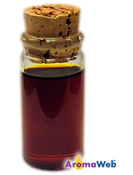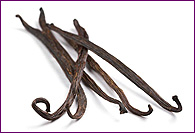Vanilla Absolute, Vanilla CO2 Extract and Vanilla Oleoresin
Vanilla planifolia

Description
The rich, beautiful flavor and aroma of vanilla comes from the seeds contained within the beans of the vanilla orchid. Unlike lavender, peppermint, cedarwood, tea tree and so many other aromatic plants that are capable of being steam distilled to produce beautiful essential oils, vanilla beans do not effectively release their precious aromatic molecules when steam distilled (or cold pressed as is the case for citrus rind essential oils).
Therefore, there is no such thing as a commercially available, beautifully aromatic vanilla essential oil. Use caution when considering purchasing any vanilla aromatic that is labeled as "Vanilla Essential Oil" because the seller likely is either being intentionally deceptive or is not knowledgeable enough to realize that what he/she is selling cannot possibly be legitimately referred to as an essential oil.
Having said that, Vanilla Oleoresin, Vanilla CO2 Extract and Vanilla Absolute are all available. Each is produced in a slightly different manner, and it's important to understand the differences between each type of vanilla. I will outline each of those further within this profile.
Aromatically, Vanilla Oleoresin, Vanilla CO2 Extract and Vanilla Absolute offer a rich, warm aroma that complements most other essential oils. The vanilla aromatics are especially lovely when blended with essential oils in the citrus, mint, wood, floral and spice families. It's a wonderful addition to soften and round out blends.
On its own, Vanilla Oleoresin, Vanilla CO2 Extract or Vanilla Absolute is certainly quite enjoyable and can assist with stress and nervous conditions (see uses below). However, they aren't the first aromatics that I'd choose for these conditions.
Vanilla Oleoresin
Vanilla Extract, like the type that is used for baking, is made by macerating vanilla beans in ethanol or another form of alcohol. The ethanol serves as the solvent. You can even make your own home made Vanilla Extract by using AromaWeb's Vanilla Extract Recipe.
Vanilla Oleoresin, to my understanding, is produced by taking Vanilla Extract and removing the ethanol or whatever solvent was used to originally produce the Vanilla Extract. Vanilla Oleoresin can be thicker than many essential oils. It depends on the Vanilla Oleoresin and on how much of the solvent has been removed. It can also depend upon your current room temperature. The cooler the oleoresin is, the thicker it will be to work with.
By its nature, Vanilla Oleoresin dissolves best in water and alcohol based solutions (i.e. a body spray). Unlike essential oils, Vanilla Oleoresin is lipophobic and does not properly dissolve in carrier oils.
Because terminology can be used erroneously, it's best to doublecheck with your supplier to confirm exactly how their oleoresin is produced.
Vanilla CO2 Extract
Vanilla CO2 Extracts are becoming more readily available. They are a beautiful, more natural and alcohol/solvent-free way to enjoy working with vanilla.
The CO2 supercritical extraction process allows the production staff to more easily control the proportions of certain desirable (and sometimes, certain undesirable) constituents that wind up in the final CO2 extract. In the case of Vanilla CO2 Extract, the aldehyde vanillin, is a crucial component in determining the aromatic profile of the extract. However, as Mark Webb confirmed in his CO2 Extract Course, working with CO2 Extracts that exceed 12% vanillin can result in an aroma that is not as full and rich.
Vanilla CO2 Extracts tend to be on the thicker side, but it depends partly on your room temperature. For more information, see AromaWeb's Using and Blending Thick Aromatic Oils article.
For more information about CO2 Extracts and how they are produced, see AromaWeb's article What is a CO2?.
Vanilla Absolute

Vanilla Absolute is produced using a solvent. Generally speaking, the solvents used to produce absolutes are synthetic. It's best to doublecheck with your supplier to find out what specific solvent was used to produce their Vanilla Absolute.
Because Vanilla Absolute can contain a trace amount of solvent, they should never be ingested. Vanilla Absolute is highly aromatic and results in a beautiful vanilla aroma. A little goes a long way. Because Vanilla CO2 Extracts and Vanilla Oleoresins are now more readily available through reputable suppliers and retailers, Vanilla Absolute is now taking a back seat though still available from some sources.
For more information about absolutes and how they are produced, see AromaWeb's article What is an Absolute?.

Vanilla Absolute Benefits and Uses
- Stress-Induced Conditions
- Nervous Anxiety
- Nervousness
- Insomnia And Restlessness
- Unexplained Painful Limbs
- Nervous Stomach
- Nausea
- Inability To Relax
Source: Valerie Ann Worwood, The Complete Book of Essential Oils and Aromatherapy, 25th Anniversary Edition (Novato, CA: New World Library, 2016, 628.
Botanical Name
Plant Family
Common Method of Extraction
Oleoresin, Solvent or CO2 Extracted
What is an Absolute?
What is a CO2?
Plant Part Typically Used
Color
Deep Brown
Consistency
Thick
Perfumery Note
Base
Strength of Initial Aroma
Strong
Aromatic Description
Vanilla Absolute, Vanilla CO2 Extract and Vanilla Oleoresin smell rich and warm and possesses a sweet vanilla aroma.
Sustainability and Conservation Status
Endangered
Source: https://www.iucnredlist.org/species/103090930/172970359
To learn more about the conservation status of essential oil bearing plants and how to use the IUCN Red List of Threatened Species, please refer to AromaWeb's Guide to Essential Oils and Sustainability.
Major Constituents
- Vanillin
- Hydroxybenzaldehyde
- Acetic Acid
- Isobutyric Acid
- Caproic Acid
- Eugenol
- Furfural
Source: Julia Lawless, The Illustrated Encyclopedia of Essential Oils (Rockport, MA: Element Books, 1995), 233.
Vanilla Absolute Safety Information
Tisserand and Young do not indicate any special precautions when using Vanilla Absolute. Reading Tisserand and Young's full profile is recommended. [Robert Tisserand and Rodney Young, Essential Oil Safety (Second Edition. United Kingdom: Churchill Livingstone Elsevier, 2014), 462-463.]
Vanilla CO2 Supercritical Select Extract
In addition to being available as an essential oil, this botanical is available from a small number of reputable sources as a CO2 extract. CO2 extracts offer many advantages. However, they can have differing safety precautions than essential oils because the natural chemistry of CO2 extracts can differ from their essential oil counterparts. Not much safety information is documented from trusted sources for CO2 extracts. Use CO2 extracts with great care and do not assume that every CO2 extract has the same safety precautions as its essential oil counterpart.
General Safety Information
Do not take any oils internally and do not apply undiluted essential oils, absolutes, CO2s or other concentrated essences onto the skin without advanced essential oil knowledge or consultation from a qualified aromatherapy practitioner. For general dilution information, read AromaWeb's Guide to Diluting Essential Oils. If you are pregnant, epileptic, have liver damage, have cancer, or have any other medical problem, use oils only under the proper guidance of a qualified aromatherapy practitioner. Use extreme caution when using oils with children and be sure to first read the recommended dilution ratios for children. Consult a qualified aromatherapy practitioner before using oils with children, the elderly, if you have medical issues or are taking medications. Before using this or any essential oil, carefully read AromaWeb's Essential Oil Safety Information page. For in-depth information on oil safety issues, read Essential Oil Safety by Robert Tisserand and Rodney Young.
Shelf Life
Important Information About the Profiles
The essential oil information provided on AromaWeb is intended for basic educational purposes only. The references to safety information, test results, constituents and percentages is generalized information. Essential oils can vary greatly in composition. The data is not necessary complete and is not guaranteed to be accurate. The essential oil photos are intended to represent the typical and approximate color of each essential oil. However, essential oil composition and color can vary based on harvesting, distillation, age of the essential oil and other factors. Profiles for several CO2 Extracts and absolutes are included within the directory, and are denoted as such.
